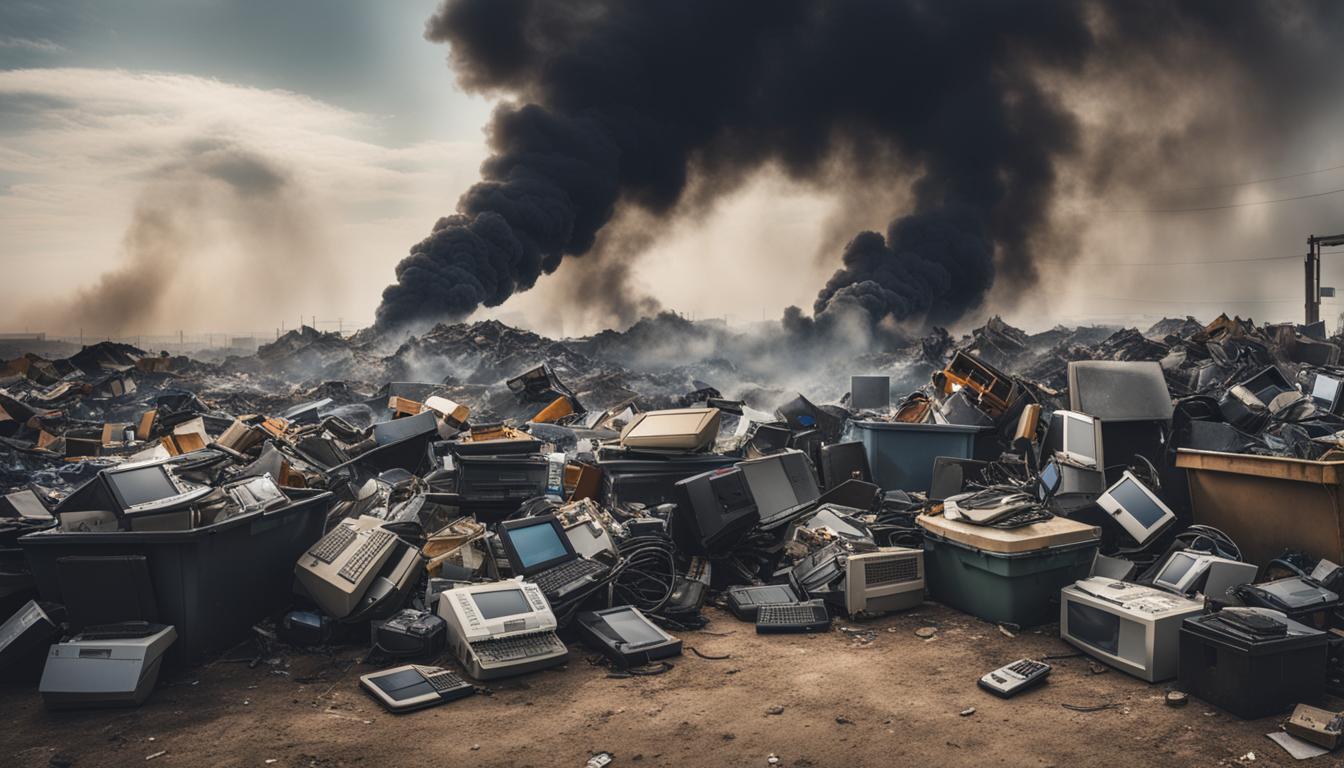The Silent Threat: E-waste Pollution and Its Effects

The Silent Threat: E-waste Pollution and Its Effects
Electronic waste pollution, commonly known as e-waste pollution, is a grave concern that poses significant environmental and health risks. The proliferation of small electronic devices like smartphones and chargers has led to the accumulation of hazardous materials such as lead, mercury, and flame retardants. These substances can seep into the soil and water, contaminating ecosystems and potentially endangering food and water sources. Moreover, improper incineration of e-waste contributes to air pollution, posing respiratory issues and silently harming both the environment and human health.
Key Takeaways
- E-waste pollution is a significant environmental and health threat.
- Improper disposal of electronic devices can contaminate soil, water, and air.
- Hazardous materials in e-waste, such as lead and mercury, pose severe health risks.
- Adopting sustainable disposal practices is crucial to mitigate e-waste pollution.
- Effective regulation and enforcement are necessary to prevent e-waste pollution.
The Importance of Sustainable Disposable Practices
Proper disposal of electronic waste (e-waste) is crucial for mitigating the environmental impact and ensuring the sustainability of our planet. Sustainable disposal practices, such as e-waste recycling and responsible waste management, play a vital role in reducing pollution and conserving valuable resources. By adopting these practices, we can contribute to a cleaner and healthier environment for future generations.
“Recycling and treating small electronic devices can make a significant difference in reducing environmental impact.”
One of the key advocates for proper e-waste disposal is Patricia Schröder, spokesperson for the producer responsibility organization Circular Energy. According to Schröder, fostering a culture of sound waste management at the individual level is crucial. This involves actively seeking out authorized recycling facilities for the proper handling and recycling of small electronic devices, rather than disposing of them in regular waste bins.
Recycling and reusing e-waste not only helps minimize the environmental pollution caused by hazardous materials but also creates job opportunities and has a positive impact on society. By supporting sustainable disposal practices, we can contribute to a circular economy where resources are conserved, waste is minimized, and the overall environmental impact is significantly reduced.
Table: Benefits of Sustainable E-waste Disposal
| Benefits | |
|---|---|
| Reduces pollution | Prevents hazardous materials from leaching into the environment |
| Conserves resources | Allows for the recovery of valuable materials such as precious metals |
| Creates job opportunities | Supports employment in the recycling and waste management sector |
| Protects human health | Minimizes the risks associated with exposure to toxic substances |
Adopting sustainable disposal practices for e-waste is not only the responsibility of individuals but also requires the support and collaboration of businesses, governments, and organizations. By working together, we can build a more sustainable future and ensure the long-term preservation of our environment and resources.
The Health Risks of E-waste Pollution on Children
The improper management of electronic waste, or e-waste, poses significant health risks, especially to children. Hazardous materials in e-waste, such as lead, mercury, and flame retardants, can have detrimental effects on the development and well-being of young individuals. The World Health Organization (WHO) highlights the importance of addressing e-waste pollution and implementing effective regulations to protect the health of children, adolescents, and expectant mothers.
Children are particularly vulnerable to the toxic chemicals present in electronic devices due to their smaller size and less developed organs. Exposure to e-waste can lead to negative birth outcomes, impaired cognitive development, respiratory issues, DNA damage, and increased risk of chronic diseases later in life. Additionally, individuals involved in the informal processing of e-waste, including children working in recycling facilities, are at risk of direct exposure to harmful substances.
It is crucial to take action to prevent e-waste pollution and safeguard the health of children and communities. Implementing and enforcing electronic waste regulations is essential to ensure proper disposal and recycling of e-waste. Education and awareness campaigns can also play a significant role in promoting responsible e-waste management practices. By taking proactive measures, we can protect the most vulnerable members of society and create a safer and healthier environment for future generations.
The Growing Volume of E-waste and its Impact
The volume of e-waste being generated globally is reaching alarming levels, presenting a significant challenge for pollution control efforts. According to the United Nations University, over 40 million tons of e-waste are produced every year, with the United States and China being major contributors. This number is expected to rise as the use of electronic devices continues to grow. Unfortunately, only a small percentage of e-waste is properly managed or recycled, leaving the majority of it to be illegally dumped, mainly in low- and middle-income countries.
E-waste pollution poses a grave threat to the environment and public health. Improper disposal and illegal dumping of electronic devices release hazardous materials into the soil, water, and air, leading to contamination of ecosystems and potential health risks for humans. The lack of appropriate e-waste management and disposal practices exacerbates climate emissions and contributes to the degradation of natural resources.
To mitigate the impact of e-waste pollution, it is crucial to establish and enforce electronic waste regulations that promote responsible disposal and recycling. Governments, industries, and individuals must work together to ensure the proper collection and treatment of e-waste, preventing its harmful effects on the environment and human health. By implementing effective pollution control measures, we can safeguard our planet for future generations.

The Impact of E-waste Pollution
To understand the gravity of the issue, let’s take a closer look at the environmental and health consequences of e-waste pollution:
| Environmental Impact | Health Impact |
|---|---|
| – Soil contamination | – Respiratory issues |
| – Water pollution | – Increased risk of chronic diseases |
| – Air pollution | – Impaired cognitive development |
| – Climate emissions | – Negative birth outcomes |
“E-waste pollution is a growing threat that requires immediate action. By controlling the volume of e-waste generated and implementing proper recycling and disposal practices, we can mitigate the environmental and health risks associated with this silent menace.” – Environmental Protection Agency
It is crucial for individuals, businesses, and governments to collaborate in addressing the issue of e-waste pollution. Through responsible management practices, we can minimize the impact on our planet and protect future generations from the harmful effects of e-waste.
The Adverse Health Effects of E-waste Exposure
Exposure to e-waste can have severe health effects, particularly on infants and children. The hazardous materials present in electronic waste, such as lead, mercury, and flame retardants, pose significant risks to human health. These toxic substances can lead to negative birth outcomes, impaired cognitive development, respiratory issues, DNA damage, and an increased risk of chronic diseases later in life. Pregnant women working in the informal waste sector are also at risk, potentially affecting the health and development of their unborn children.
Proper management and disposal of e-waste are crucial to prevent these adverse health effects. Implementing and enforcing regulations for electronic waste disposal and recycling is necessary to minimize exposure to hazardous materials. It is also essential to raise awareness among individuals and organizations about the importance of e-waste management. By promoting sound waste management practices and ensuring the sustainable disposal of electronic waste, we can significantly reduce the health risks associated with e-waste exposure.
“The adverse health effects of e-waste exposure are a growing concern worldwide. It is crucial to take immediate action to protect the health of individuals and prevent further harm to the environment.” – Dr. Samantha Johnson, Environmental Health Specialist
Table: Comparison of Health Risks Associated with E-waste Exposure
| Hazardous Material | Health Risks |
|---|---|
| Lead | Impaired cognitive development, neurological damage, and behavioral disorders |
| Mercury | Respiratory issues, kidney damage, and neurological disorders |
| Flame retardants | Disruption of hormone systems, reproductive disorders, and increased risk of cancer |
It is clear that the proper management and disposal of e-waste are essential to protect public health. Governments, businesses, and individuals must work together to ensure the safe handling and disposal of electronic waste. Implementing effective e-waste management strategies, such as establishing recycling programs and promoting responsible consumer behavior, can help mitigate the adverse health effects associated with e-waste exposure. By taking action now, we can create a healthier and more sustainable future for all.
The Global Scale of E-waste Pollution
The global volume of e-waste is rapidly increasing, with an estimated 93.5 million tons generated in 2016. This is due to the growing use of electronics, rapid obsolescence, and limited recycling efforts. Only a small percentage of e-waste is collected and appropriately recycled, leading to significant environmental pollution. Informal workers often bear the burden of processing e-waste, exposing themselves to harmful substances. The need for effective e-waste management and environmentally sound disposal practices is urgent to address this escalating problem.
Proper electronic waste disposal is crucial in mitigating the environmental impact of e-waste pollution. The improper disposal and inadequate recycling of electronic devices contribute to the growing volume of e-waste globally. This not only poses a threat to the environment but also affects the health and livelihoods of individuals involved in waste handling, particularly the informal workers.
Efforts must be made to improve e-waste recycling and pollution prevention. Governments, organizations, and individuals must work together to establish proper e-waste management systems, including the establishment of recycling facilities, implementing regulations, and promoting awareness about the importance of responsible e-waste disposal. By adopting sustainable practices and investing in recycling infrastructure, we can minimize the global scale of e-waste pollution and protect both the environment and human health.
The Global Volume of E-waste
| Year | Global E-waste Volume (in million tons) |
|---|---|
| 2016 | 93.5 |
| 2017 | 99.3 |
| 2018 | 109.3 |
| 2019 | 53.6 |
The Importance of Taking Action
The global issue of e-waste pollution calls for immediate action to protect both the environment and human health. Effective e-waste management, recycling, and pollution control are essential to mitigate the adverse effects of electronic waste on our planet.
“We must implement and enforce regulations for proper e-waste disposal, monitor exposure and health outcomes, and promote the reuse of materials,” emphasizes Patricia Schröder, spokesperson for Circular Energy, a leading producer responsibility organization. By taking these crucial steps, we can reduce the environmental impact of e-waste and safeguard our communities.
“Proper management and disposal of e-waste are not only necessary to prevent pollution but also to protect the health and well-being of individuals,”
adds the World Health Organization (WHO). Through capacity building, research, and advocacy, the health sector plays a vital role in addressing the health risks associated with e-waste.
“It is imperative that we advocate for the production of more durable electronic equipment and encourage the adoption of sustainable disposal practices,” stresses Schröder. By doing so, we can create lasting change and ensure a healthier future for generations to come.
Key Actions for E-Waste Management, Recycling, and Pollution Control:
- Implement and enforce regulations for proper e-waste disposal
- Monitor exposure and health outcomes related to e-waste pollution
- Promote the reuse and recycling of materials from e-waste
- Advocate for the production of more durable electronic equipment
- Educate individuals and organizations about the importance of sustainable disposal practices

Conclusion
E-waste pollution poses a significant environmental and health threat, with far-reaching consequences for ecosystems and human well-being. The improper disposal and processing of electronic devices containing hazardous materials contribute to the pollution of soil, water, and air. This calls for urgent action to mitigate the environmental impact of e-waste and safeguard the future.
Raising awareness about the dangers of e-waste pollution is crucial. By educating individuals and organizations about sound waste management practices, we can promote sustainable disposal and recycling of electronic waste. It is imperative that we take responsibility for our electronic devices and ensure they are properly managed to minimize their negative impact on the environment.
Furthermore, governments need to implement and enforce regulations that govern the proper disposal of e-waste. Monitoring exposure and health outcomes, as well as advocating for the production of more durable electronic equipment, are essential steps in tackling this issue. The health sector plays a vital role in preventing and addressing the health risks associated with e-waste pollution through research, advocacy, and capacity building.
Together, through collective action and a commitment to responsible e-waste management, we can make a positive difference. By prioritizing the proper handling, recycling, and reuse of electronic waste, we can reduce the adverse environmental and health outcomes caused by e-waste pollution. Let us work together to protect the environment and future generations from the harmful effects of electronic waste.
Content is originally from IT Recycle.
Please contact press@gizmogo.com for copyright concerns.
© 2025 UC Technology Inc . All Rights Reserved.